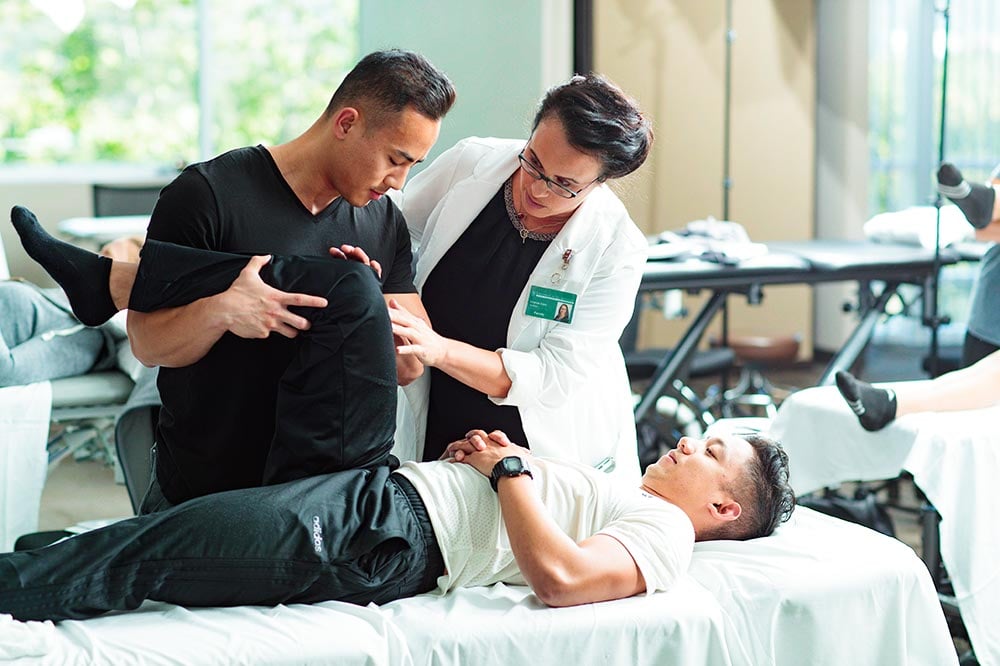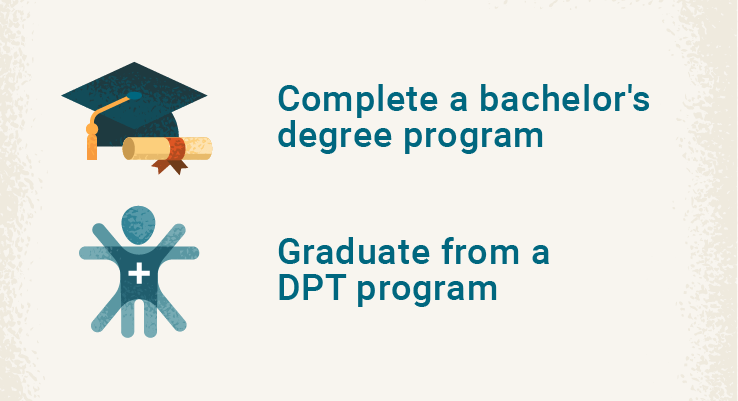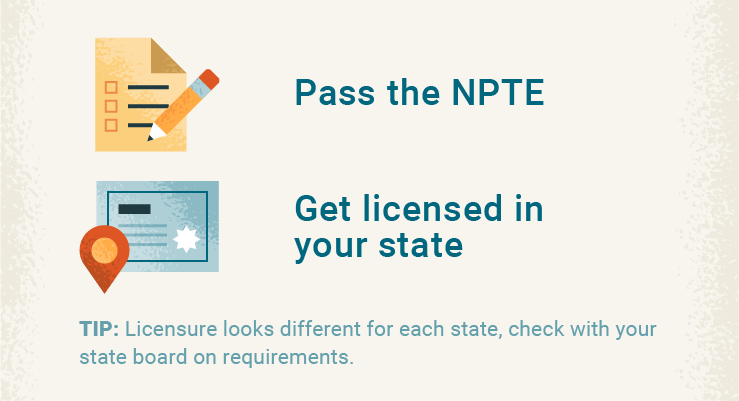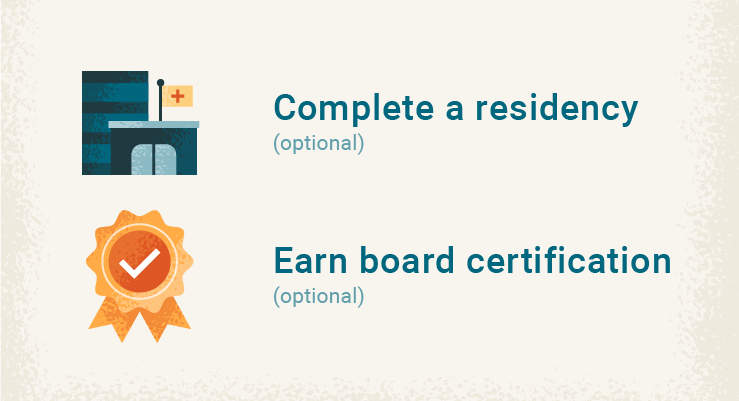How To Get Into Physical Therapy School

Physical therapists help injured and ill patients manage their pain, improve their range of motion, and get back to functioning at their highest potential.
Joining this rewarding career requires years of education, mastery of a variety of skills, and both national and state licensure. To help you get started on your path to becoming a licensed physical therapist, we outline six steps, plus other requirements to think about.
Table of Contents
- Physical Therapy Education
- Physical Therapy Requirements
- After Graduation
- Launching Your Physical Therapy Career
Physical Therapy Education

Whether you're currently in high school or college, choosing a grad school that offers a robust DPT degree will be an important step along your journey to becoming a practitioner.
Step 1: Earn a Bachelor's Degree in a Related Field
Typically, students will need to earn a bachelor's degree in a field related to health science, exercise, and/or sports. For some graduate programs, students may also be required to complete specific prerequisites, such as courses in physics, kinesiology, biology, chemistry, physiology, and anatomy.
Research the prerequisites of the doctoral degree programs you are interested in and be sure to take the classes you need.
Step 2: Complete a Doctor of Physical Therapy Degree
Next, students must enroll in and complete an accredited Doctor of Physical Therapy (DPT) program. DPT degree programs begin with didactic courses in pathophysiology, imaging, biomechanics, anatomy, and more. During the second year of the program, students complete their white coat ceremony and enter the clinic for hands-on rotations supervised by a clinical instructor.
More innovative schools may also include a simulation component. For example, the University of St. Augustine for Health Sciences (USAHS)—the largest physical therapy school in the United States1—features a state-of-the-art simulation center on each of its five campuses. There, DPT students have the chance to practice clinical interactions with mock patients before they enter the clinic.
Some graduate schools also offer innovative scheduling options. USAHS offers its DPT program in two formats:
- Residential DPT: This format blends online coursework with in-person clinical labs on weekdays. It typically takes less than three years to complete.
- Flex DPT: This format blends online coursework with in-person clinical labs on select weekends each month. Designed for working students, it typically takes four years to complete.2
Learn More About Our DPT Programs
Physical Therapy Requirements
After you obtain your doctoral degree, you must become licensed in the state where you will practice.

Step 3: Pass the NPTE
In order to become a licensed physical therapist, you must pass the National Physical Therapy Examination (NPTE), which is given by the Federation of State Boards of Physical Therapy (FSBPT). The computer-administered exam consists of 250 multiple-choice questions split into five sections. It is scored on a scale of 200–800; scoring a 600 or above is considered passing. The NPTE is offered four times each year: in January, April, July, and October. The FSBPT allows candidates to take it up to three times in one year. In 2019, 91% of first-time candidates who were graduates of
U.S.–accredited PT programs passed the NPTE.3
Step 4: Obtain a License to Practice
Licensure looks different within each state. Most states require practitioners not only to pass the NPTE but also to fulfill additional criteria, such as compliance training, background checks, etc. To maintain licensure, physical therapists must meet continuing education requirements every two years in most states. Continuing education courses keep physical therapists current with the profession's standards and trends.
Check with your state board to learn about your licensing requirements.
After Graduation for Physical Therapists
Once you've become a licensed physical therapist, you may consider furthering your practice with a residency or fellowship program. Or, you can get board-certified with a specialty focus.

Step 5: Complete a Residency Program (optional)
A clinical residency is a post-graduate program that includes additional training, coursework, and clinical experiences. A residency is a good way to begin specializing in your area of greatest interest. Physical therapy fellowship programs are also available.
Step 6: Earn Board Certification (optional)
After becoming licensed and gaining work experience in the field, physical therapists have the opportunity to become board-certified clinical specialists through the American Board of Physical Therapy Specialties (ABPTS).
There are ten specialty areas of physical therapy: Cardiovascular and Pulmonary, Clinical Electrophysiology, Geriatrics, Neurology, Oncology, Orthopedics, Pediatrics, Sports, Wound Management, and Women's Health.
In order to become board-certified, applicants must at a minimum pass an exam and complete an APTA-accredited residency program, or at least 2,000 hours of clinical work. Additional requirements may apply depending on the specialty area.
Launching Your Physical Therapy Career
Physical therapy is a rewarding career path—you'll have the opportunity to change people's lives for the better using traditional methods and some non-traditional treatments like cupping therapy. Here are some other aspects to consider as you prepare to launch your career.
Which Qualities Should a Physical Therapist Cultivate?
Qualities that will help you in your PT career include compassion, communication skills, attention to detail, dexterity, physical stamina, creative thinking, and the ability to manage time wisely.
Where Do Physical Therapists Work?
Physical therapists work across many different settings with a variety of patient ages and issues, so you will have a wealth of options and opportunities when beginning your career.
Physical therapy settings include:
- Hospitals
- Outpatient clinics
- Sports training and fitness centers
- Inpatient rehabilitation facilities
- Nursing and extended care facilities
- Patient homes
- Schools and education centers
- Virtually
If you have a taste for independence and entrepreneurship, you can choose to start your own private practice. Alternatively, you could pursue a role in healthcare leadership or join an existing office with other physical and occupational therapists.
How Long Does It Take to Become a Physical Therapist?
Becoming a physical therapist can take anywhere from three to eight years. Before you can enroll in a DPT program, you must first earn a bachelor's degree from an accredited institution, ideally with a major in health sciences. A bachelor's degree typically takes three to four years to complete for full-time students. Then you will need to enroll in a Doctor of Physical Therapy (DPT) program, which will take about three to four years to complete.
How Much Do Physical Therapists Make?
The median salary for a physical therapist was $89,4404 in 2019. However, salaries vary widely based on the position, setting, experience level, education level, and geographic location.
At the University of St. Augustine for Health Sciences, we offer an esteemed Doctor of Physical Therapy program that challenges students to be versatile, empathetic, and well-skilled practitioners. Our DPT students learn to assess patients, create treatment plans, and use hands-on therapy techniques in real-world simulations.
The largest PT school in the United States,* the University of St. Augustine for Health Sciences (USAHS) offers a hands-on Doctor of Physical Therapy (DPT) degree. Join a collaborative cohort of peers who learn under the mentorship of expert faculty-practitioners. Practice with mock and real patients in our state-of-the-art simulation centers and learn anatomy with our high-tech tools. Prepare for clinical practice with a wide range of patients, as well as for advanced roles in research, practice leadership, and policymaking. Residential (online coursework + in-person labs on weekdays) and Flex (online coursework + in-person labs on weekends) formats are available.
*Based on total DPT degrees conferred, as reported by the Integrated Postsecondary Education Data System (IPEDS). Data is captured by IPEDS through interrelated surveys conducted annually by the U.S. Department of Education's National Center for Education Statistics (NCES). https://nces.ed.gov/ipeds/
- Based on total DPT degrees conferred, as reported by the Integrated Postsecondary Education Data System (IPEDS). Data is captured by IPEDS through interrelated surveys conducted annually by the U.S. Department of Education's National Center for Education Statistics (NCES). https://nces.ed.gov/ipeds/ [↩]
- The program is designed to be completed in this amount of time; however, the time to completion may vary by student, depending on individual progress, credits transferred, and other factors. [↩]
- FSBPT, "NPTE Exam Year Reports": https://www.fsbpt.org/Free-Resources/NPTE-Pass-Rate-Reports/NPTE-Exam-Year-Reports [↩]
- Bureau of Labor Statistics, U.S. Department of Labor, Occupational Outlook Handbook , "Physical Therapists," last modified Sept. 1, 2020: https://www.bls.gov/ooh/healthcare/physical-therapists.htm [↩]
How To Get Into Physical Therapy School
Source: https://www.usa.edu/blog/how-to-become-a-physical-therapist/
Posted by: hoovermiscacer.blogspot.com

0 Response to "How To Get Into Physical Therapy School"
Post a Comment